10 Essential Features for a Fitness App | Build a Fitness App Today
 21 August 2024
21 August 2024🔊 Listen to the Summary of this article in Audio
In a world where our smartphones can count our steps, measure our heartbeats, and coach us through workouts, are we witnessing the dawn of a new era in personal fitness? The fitness app market is surging towards an astounding USD 10.04 billion by 2028, growing at a breakneck pace of 9.99% CAGR. This meteoric rise reflects a global shift towards digital solutions for health and wellness. No longer a luxury, fitness apps have become an essential tool for every fitness enthusiast looking to achieve their fitness goals.

From the casual jogger to the dedicated gym-goer, these apps cater to every type of fitness journey. They’re revolutionizing how we approach exercise, nutrition, and overall well-being. Whether you’re tracking steps, counting calories, or even controlling gym equipment via IoT, there’s an app for that. For those venturing into mobile app development, creating a workout app that stands out requires careful consideration of key features.
A successful app development company knows that incorporating the top 10 essential features is crucial for user retention and satisfaction. These include personalized workout plans, wearable tech integration, and gamification elements that make fitness both fun and engaging. Moreover, features that allow users to monitor their fitness progress, connect with social networks, and access health metrics can significantly enhance the app’s appeal. As we delve into these features, remember: the right combination can transform a simple mobile application into a powerful ally for those striving to achieve their fitness aspirations.
Key Takeaways
- The fitness app market size is anticipated to grow substantially, making now an opportune time to create a fitness app and invest in its development.
- When you make a fitness app, it must offer a blend of essential features catering to workout tracking, nutrition, and user engagement to be truly effective.
- Successfully building a mobile app requires careful consideration of must-have features like personalization, tracking, social sharing, and integration with both wearable and non-wearable devices.
- Among the crucial features of fitness apps, incorporating gamification and community challenges can significantly improve user retention and app popularity.
- With the rise of the wearable devices market, synchronization capabilities are no longer just optional fitness app features but are expected by users for a holistic fitness tracking experience.
- The most successful fitness app provides a comprehensive suite of tools that cater to various aspects of health and wellness, ensuring users have everything they need to achieve their fitness goals in one place.
1. Workout Tracking
In today’s fast-paced world, we all seek smart ways to stay fit. A well-designed fitness mobile app can be a game-changer, especially when it comes to workout tracking. This feature is invaluable as it allows users to visualize their fitness journey through data, enabling them to monitor progress and make informed decisions about their health and exercise routines.
Real-time feedback on workout results acts as a powerful motivator. Seeing tangible achievements, such as calories burned or distance covered, encourages consistent use of the health and fitness app and helps users maintain a regular workout schedule. This is why workout tracking is often considered one of the most essential features that any type of fitness app should include.
For instance, consider the Future app, a prime example of how effective tracking can boost user engagement. Its users completed an impressive average of 170 workouts in a year, driven by the app’s comprehensive tracking capabilities. This app goes beyond basic tracking by integrating with gym equipment to provide detailed metrics and even generates year-end reports, making it a must-have tool for fitness enthusiasts.
When a fitness app development company focuses on creating robust tracking features, they’re essentially providing users with a digital personal trainer. Many personal trainer apps now incorporate advanced tracking capabilities, offering users professional-level insights into their fitness journey. This level of detailed tracking and analysis is transforming how people approach their fitness goals, making it an indispensable feature for anyone serious about improving their physical health and well-being.
| Feature | Description | User Impact |
|---|---|---|
| Automatic Data Recording | Automatic synchronization with gym equipment and IoT devices for seamless tracking. | Enhanced user convenience and accuracy in tracking workouts. |
| Custom Alerts | Prompt timers and audio cues to maintain workout intensity and rest periods. | Ensures effective time management and workout effectiveness. |
| Progress Reporting | Comprehensive insights into workouts, including year-end summaries and progress charts. | Users can visualize their progress, boosting motivation and adherence to scheduled workouts. |
| Coaching Integration | Direct messaging with coaches and personalized training feedback. | Personalized guidance enhances training outcomes and fosters a supportive fitness community. |
Our expert developers can help you create a customized fitness application with all the essential features to engage and retain users.
2. Personalized Workout Plans
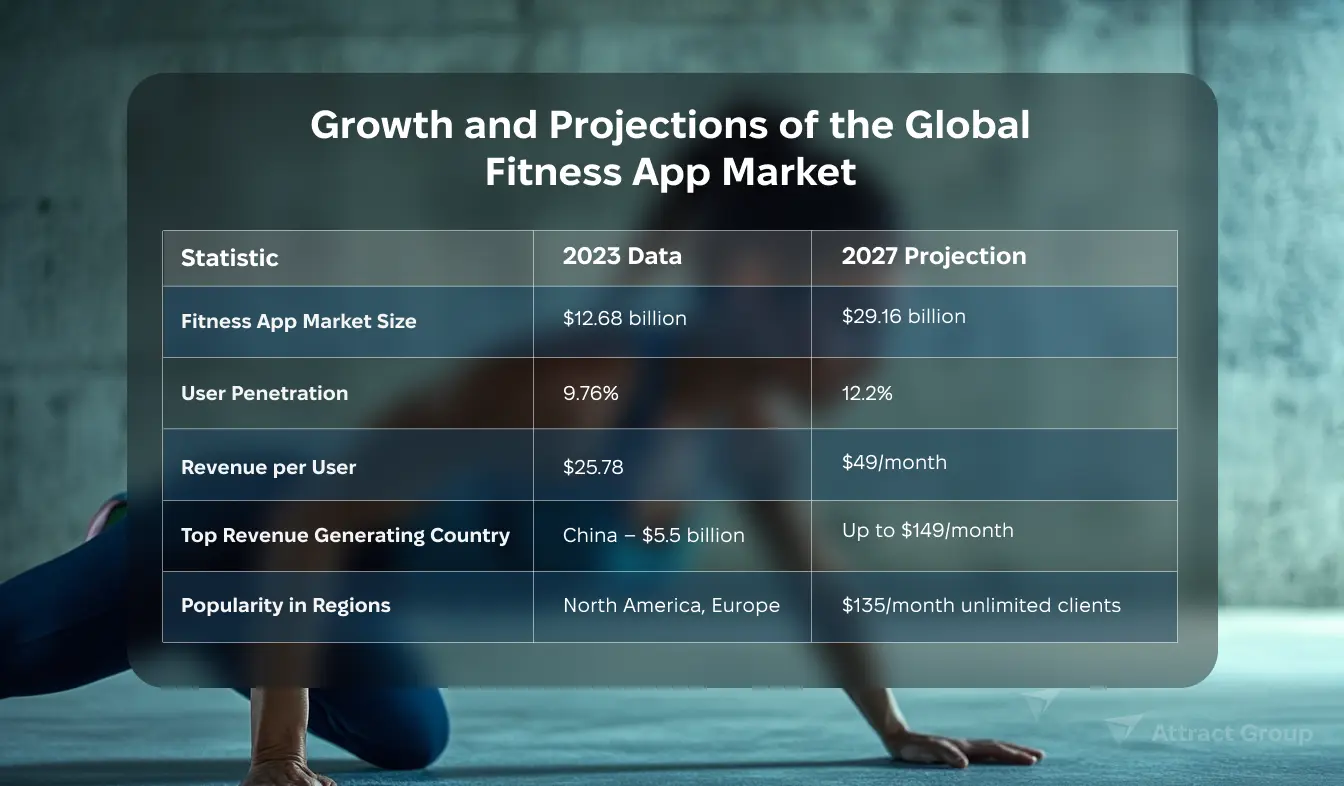
Personalized workout plans are among the must-have features for fitness apps in today’s rapidly expanding market. These tailored regimens significantly boost user engagement and retention by helping individuals achieve their fitness goals. By customizing exercise routines to each user’s fitness level and objectives, these plans transform generic apps into powerful tools that can help users stick to their fitness journey.
One of the key features of a fitness app that truly resonates with users is its ability to provide personalized fitness guidance. Advanced fitness apps leverage algorithms and AI to analyze user data such as age, current fitness level, and personal preferences. This analysis allows the app to suggest workouts that align perfectly with the user’s aims and capabilities, not only facilitating goal achievement but also maintaining motivation.
As fitness goals evolve, so too must virtual fitness platforms. The app you want should be adaptable, allowing users to modify their workouts based on progress and changing objectives. This flexibility enhances interactivity and sustains user engagement over time, making it a crucial aspect of any successful fitness app.
The table below illustrates the growth of the fitness app market, underscoring the pivotal role these apps play in promoting personalized fitness worldwide:
| Statistic | 2023 Data | 2027 Projection |
|---|---|---|
| Fitness App Market Size | $12.68 billion | $29.16 billion |
| User Penetration | 9.76% | 12.2% |
| Revenue per User | $25.78 | $70.20 |
| Top Revenue Generating Country | China – $5.5 billion | Projected increase |
| Popularity in Regions | North America, Europe | Expected to grow |
3. Nutrition Guidance and Tracking
Nowadays, fitness apps are getting better by including nutrition tracking. This is crucial, not just to watch calories but to promote a healthy lifestyle. Getting fit goes hand-in-hand with what you eat. So, it’s key for these apps to offer personalized nutrition guidance.
Mixing exercise with good nutrition leads to better health. This combo boosts the results of your fitness plan. Fitness apps use nutrition tracking to give details on your diet. They help you keep a healthy lifestyle by offering balanced health advice.
- Nutrition Tracking: Apps like MyFitnessPal and Cronometer provide updates on what you eat, helping you make better food choices.
- Meal Planning: Planning your meals ahead can make sticking to your diet easier and simplify managing your nutrition.
- Health Tips on Your Fitness Apps: Health tips in your apps encourage you to eat better and fit them into your exercise routine.
Personalized nutrition guidance gives advice suited to each person. It suggests meals and portion sizes based on your fitness level and goals.
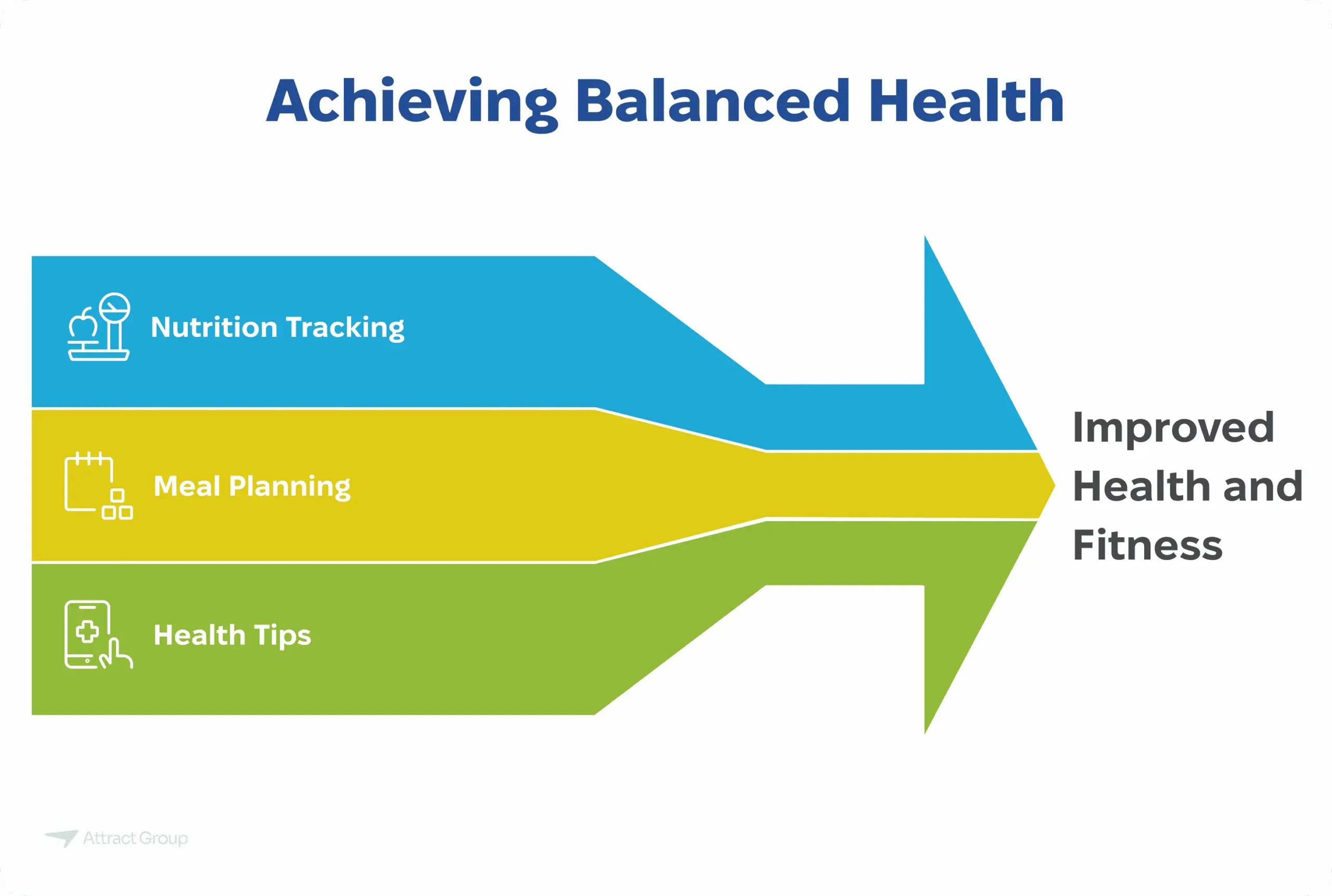
It’s important for apps to check the food information they provide. Tools like Cronometer verify user-added foods to ensure the data is reliable. Others, like MyFitnessPal, have special features for a deeper look into your diet. This shows why being precise in nutrition tracking is crucial.
- Accuracy of Information: Having verified food info means you can trust your diet tracking to be right and complete.
- Convenience Features: Paid features, like barcode scanning, make logging meals quick and accurate.
- Subscription Models: Your budget may affect access to advanced features. Some apps, like Lose It! and MyFitnessPal, have subscriptions for more detailed tracking.
Offering nutrition tracking and personalized nutrition guidance in fitness apps is essential. It improves how users manage their diet and impacts their health positively. These features are now key parts of the fitness and wellness digital market.
4. Social Integration Features
Modern fitness tracking apps are great at mixing social media with fitness, making a lively community. Users can connect, share, and challenge each other, which keeps them interested and active. Social features in these apps help everyone feel close and motivated.
Adding social media to a fitness app changes a solo workout into a shared adventure. Apps introduce fitness challenges, making users feel supported. It’s not just competing but also reaching goals together. Let’s look at how these features build community:
- Sharing Progress: Users can post their achievements online, getting cheers and encouragement.
- Fitness Challenges: Users engage in challenges with friends, boosting interaction.
- Leaderboards: Users can compare their progress, sparking healthy competition.
- Group Activities: Users can join virtual workout sessions, finding others with similar goals.
Social media in fitness apps offers accountability and rewards, keeping motivation high. Studies show apps with good social features have more daily users. Sharing wins or joining group challenges makes working out fun and motivating.
By adding social features and challenges, fitness apps create community and improve the app’s appeal. Users get to share their workout stories and support each other. This makes achieving health goals a shared journey, bringing everyone closer.
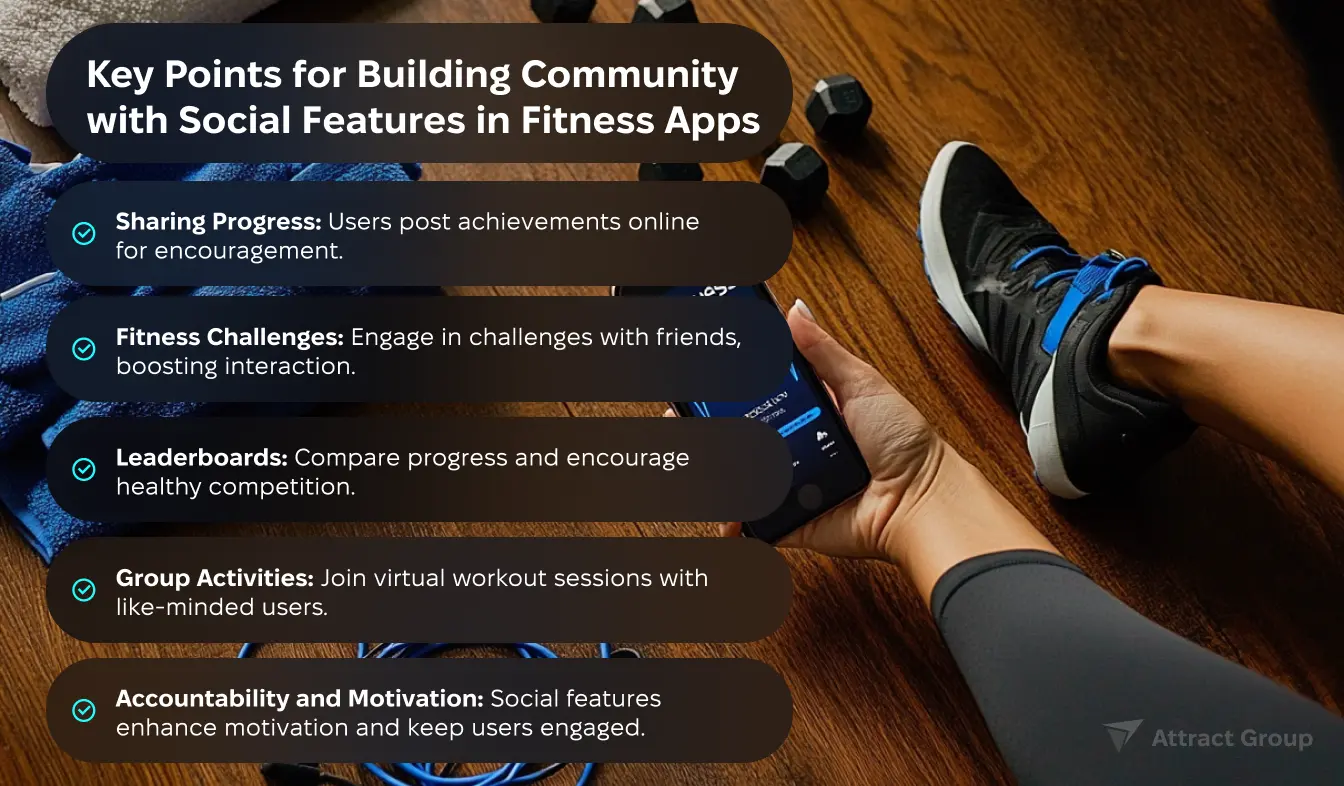
5. Real-Time Progress Monitoring
In the world of fitness app development, real-time progress monitoring is key. It boosts user experience and keeps them coming back. It helps track their workout progress with visual cues. These cues keep users motivated throughout their fitness journey.
Real-time monitoring is great for visual learners. It compares a user’s current progress with their goals. This shows them how far they’ve come and what needs work. Studies show fitness app daily users increased by 24% recently. This highlights the value of having interactive and motivational features.
Setting and tracking goals is also crucial. It gives users important feedback. Apps like Runtastic and Strava let users see their activity summaries. This is a feature users love. It plays a big role in keeping them satisfied and coming back.
| Feature | User Benefit | Impact on Engagement |
|---|---|---|
| Daily Progress Tracking | Enables users to monitor daily exercise achievements | Increases daily app opens and user retention |
| Goal setting and achievements | Helps users establish and accomplish fitness goals | Enhances long-term engagement and motivation |
| Visual progress graphs | Offers a visual representation of workout progress | Boosts user motivation through visual accomplishments |
| Integration with wearables | Provides synced real-time data on users’ physical activities | Facilitates reliable and continuous progress tracking |
Fitness apps combine tracking features and visuals well. This keeps users active and helps the market grow. By using advanced tracking, app developers improve the user experience. This matches the industry’s wider goals and expectations.
6. Health and Fitness Metrics
The fitness world is changing fast. Health metrics in fitness apps play a key role for users wanting better health. These metrics give a clear picture of important health signs. They help users set and reach personal health goals.
Fitness trackers and health gadgets give live data on important health stats. They monitor sleep, hydration, heart rate, and calories burned. This data helps users meet their fitness goals with accurate info.
Getting fit is not just about exercising. It’s also about understanding different health aspects and using tech for a complete well-being view. Next, we look at important health and fitness metrics for improving health.
| Metric Type | Details | Benefits |
|---|---|---|
| Sleep Monitoring | Tracks duration and quality of sleep | Improves mood, enhances cognitive function |
| Physical Activity | Records steps, distance, and active minutes | Boosts heart health, aids weight management |
| Hydration Levels | Tracks water intake | Prevents dehydration, promotes healthy skin |
| Caloric Burn | Estimates calories expended through activities | Supports weight loss and metabolic health |
| Heart Rate Monitoring | Provides continuous or periodic heart, rate data | Helps in assessing cardiovascular and overall health |
7. Community Challenges and Competitions
Gamification in fitness apps turns workouts into a fun game. Community challenges and competitions make exercises exciting. Users deeply engage with the app and aim to beat their fitness goals through healthy competition.
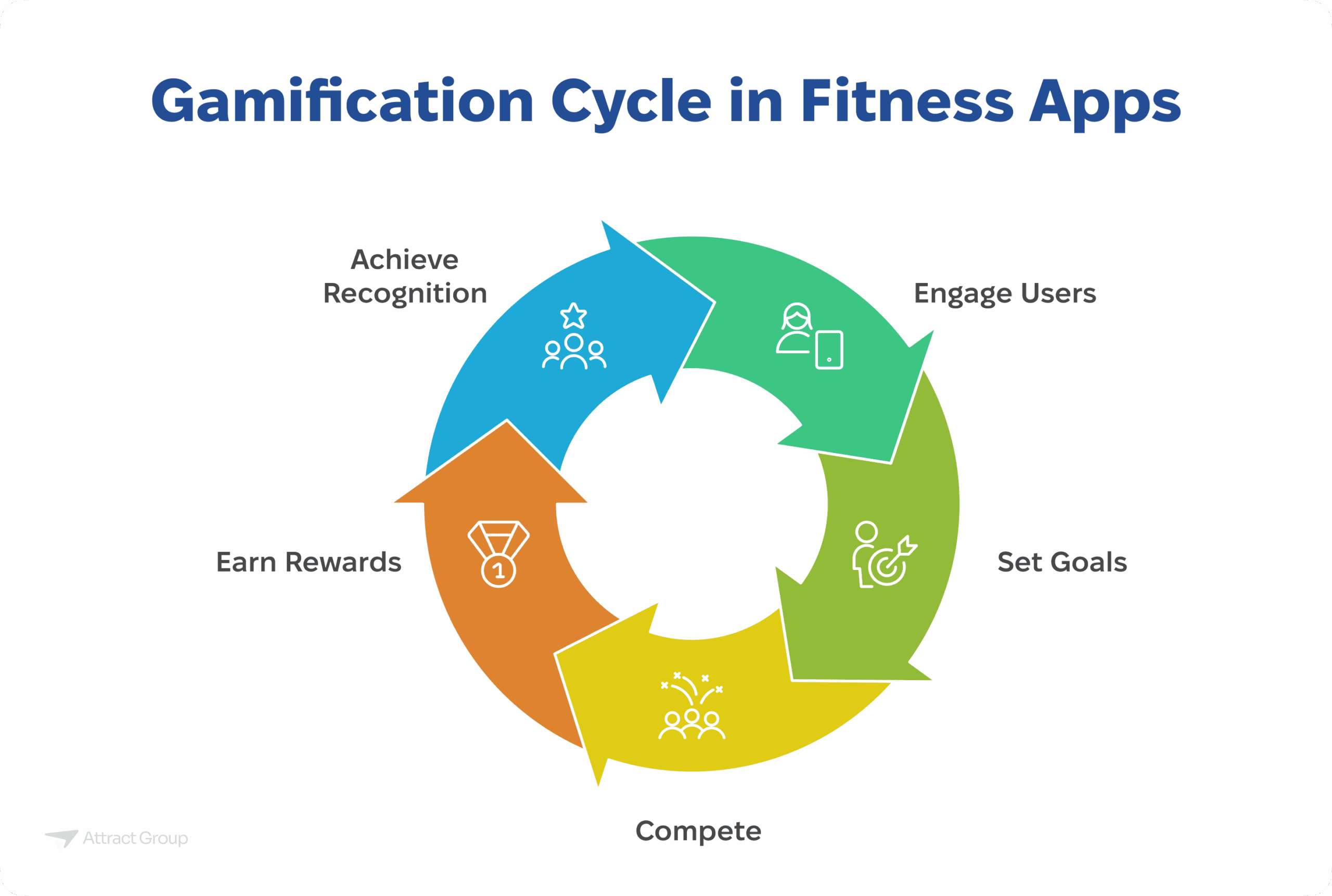
Fitness app challenges and competitions tap into our love for competing and achieving. Giving rewards like medals or points makes users keep coming back. This turns daily exercises into quests for personal betterment and being recognized by the community.
Below, we explain how these competitive elements build community and keep users coming back:
| Feature | Description | User Impact |
|---|---|---|
| Achievement Medals | Users earn Bronze, Silver, and Gold medals based on their movement and activity levels, which are tracked and synced with health apps like Apple’s Health App. | Encourages consistent activity among users as they strive to unlock higher-tier medals. |
| Virtual Challenges | Challenges such as #StayHomeStayFit or global fitness challenges organized by brands like VIVA Fitness engage users by connecting them with broader, like-minded communities. | Provides motivation during specific events or periods, increasing user activity and retention. |
| Charity and Fundraiser Events | Events like those organized by Barry’s Bootcamp UK leverage workouts for charitable causes, which not only helps the community but also boosts participant’s morale. | Enhances user’s emotional connection with the app, promoting both brand loyalty and social good. |
| In-App Competitions | User engagement peaks during in-app events where attendees can see real-time leaderboards and compare performances with peers. | Drives daily logins and increases the overall time spent on the app as users compete and track their progress. |
8. Virtual Coaching and Support
In the health and fitness world, virtual coaching is a big deal. It lets people get professional training support from any place, breaking down location barriers. We’re diving into how these features make apps more engaging and functional.
Thanks to smart app developers, it’s now possible to feel like you’re right there with a fitness expert. Using AI and AR, apps offer customized training that feels personal. This cool tech makes apps not just fun but also super helpful for hitting fitness targets.
Virtual coaching meets different needs and helps coaches reach more people. Let’s look at how some platforms include this feature and their costs:
| Platform | Pricing for Individual Coaches | Pricing for Businesses |
|---|---|---|
| Healthie | $29/month | Up to $149/month |
| Mindbody Business | Starts at $139/month | Up to $699/month |
| My PT Hub | $20/month | $49/month |
| Quenza | Starts at $50/month after free trial | Up to $149/month |
| PracticeBetter | Free up to 3 clients | $135/month unlimited clients |
These services offer many tools to improve virtual coaching. They help set goals, track progress, and give feedback. It helps trainers give professional training support well.
Adding great virtual coaching to a fitness application boosts user happiness. It also improves the app’s place in the market by attracting more users who want online fitness solutions.
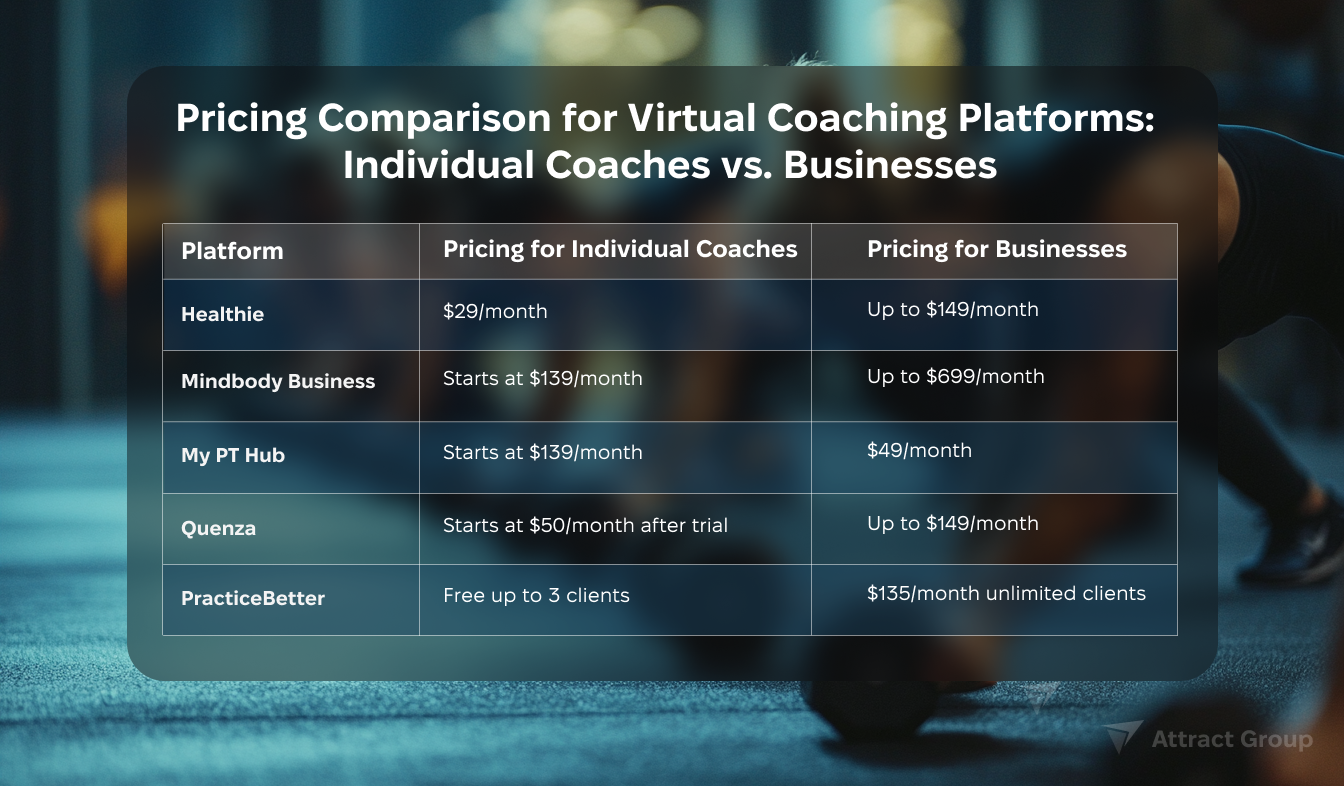
9. Accessibility Features
An app company needs to make sure its fitness advice is open to everyone. This means they should design apps that everyone, including those with disabilities, can use. When developers focus on making their apps accessible, more people can enjoy them. And, it helps everyone get the most out of their fitness journey.
To really be accessible, fitness apps must have features that meet different needs. Things like voice commands and high-contrast colors make apps easier for everyone to use. As technology advances, apps will get even better at helping everyone stay fit and healthy.
Let’s look at a top smartwatch’s features to see how they help make fitness apps more accessible:
| Feature | Description | Benefit |
|---|---|---|
| VoiceOver | Supports multiple languages and is compatible with all native apps. | Allows visually impaired users to receive audio feedback, making app navigation smoother. |
| Zoom | Enables magnification up to 15 times the native size. | Helps users with low vision focus on specific areas of the app interface. |
| High Contrast | Adjustable color settings for enhanced visibility. | Improves readability for users with color vision deficiencies. |
| Bold Text | Makes text appear darker and thicker. | Increases text visibility, aiding users with visual impairments. |
| Reduce Motion | Simplifies animation and reduces motion effects. | Essential for users sensitive to motion, preventing discomfort and nausea. |
| Wheelchair Accessibility | Tailored algorithms to track wheelchair movement accurately. | Enables precise activity tracking and fitness monitoring for wheelchair users. |
| AssistiveTouch | Allows control without the need to touch the screen. | Facilitates usage for individuals with limited manual dexterity or motor impairments. |
For app companies, focusing on these design features isn’t just about best practices. It’s about making the digital world accessible to all. By doing so, they show they care about every user’s experience.
10. Integration with Wearable Devices
Wearable devices like smartwatches and fitness bands are changing the way we track health and fitness. They allow for an easy connection with fitness apps. This connection boosts the app’s features and makes everyday fitness tracking better.
Fitness trackers and smartwatches lead the charge in this area. They offer advanced tracking of steps, heart rate, and sleep. By connecting with fitness apps, they give a complete overview of health and activities. This helps users manage their health better and stay motivated.
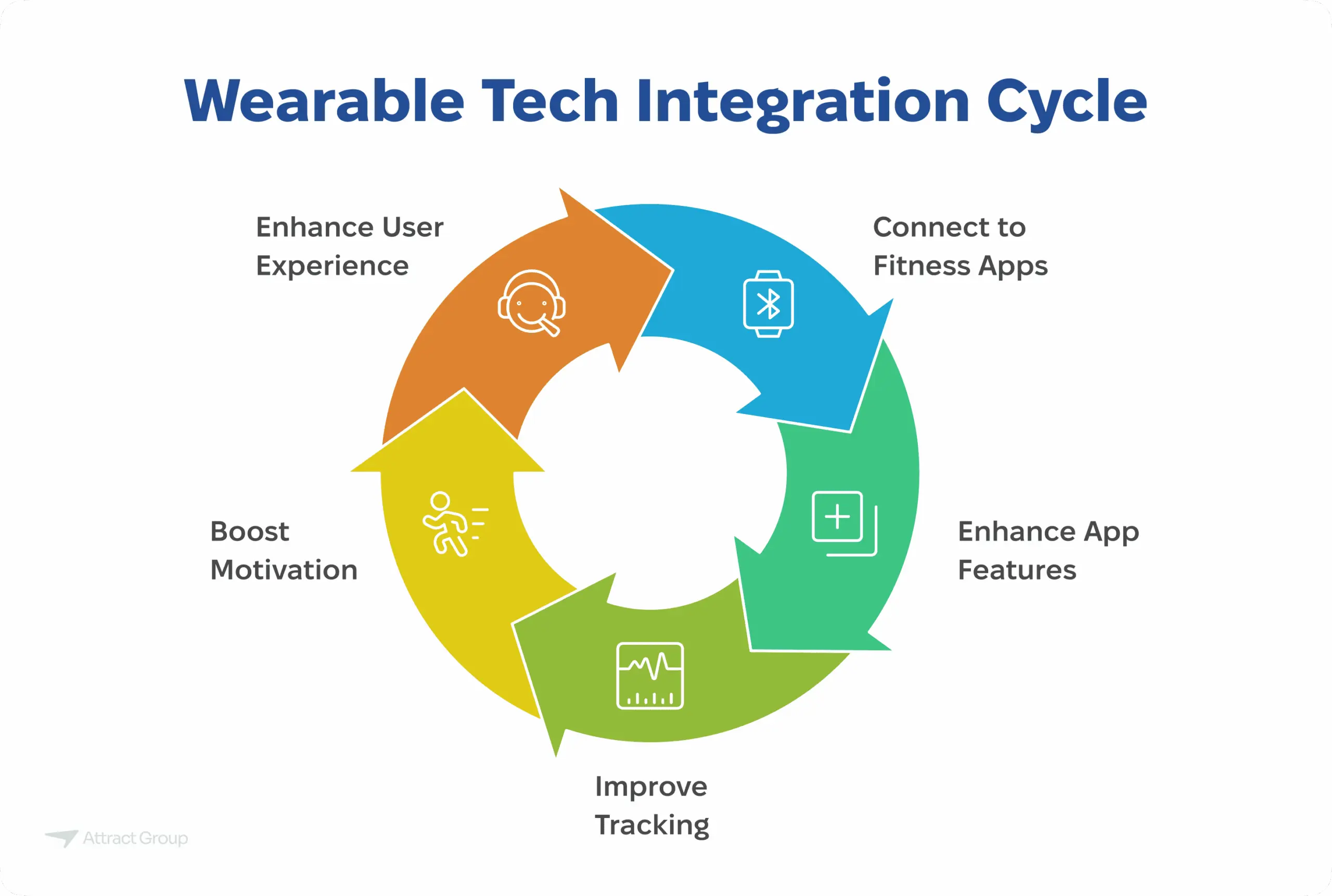
Smart clothing and glasses are also making waves in wearable tech. They bring new features such as augmented reality and precise tracking. This is changing how we monitor fitness and health, especially in sports and healthcare.
Adding wearables to fitness apps does more than track activities. It also brings features like notifications and music controls. This integration improves how users interact with the app. It makes using the app more convenient and enjoyable.
| Feature | Device Type | Benefits |
|---|---|---|
| Health and Fitness Tracking | Smartwatches, Fitness Bands | Monitors vital health statistics for comprehensive health management |
| Hands-Free Convenience | Smart Glasses, Smart Clothing | Provides real-time data and guidance without interrupting user activities |
| Voice-Based Control | Devices with Amazon Alexa Voice Service | Enables interactive and voice-controlled app functionalities |
| Customizable Interfaces | Wear OS Devices | Offers tailored app experiences with customizable watch faces and settings |
Innovative Features to Set Your App Apart
The fitness app scene is constantly changing. To stand out, you need something special like a successful fitness app. This often means adding innovative features in fitness apps. Think about using advanced features like AI and VR. They can draw users in and keep them motivated in new and exciting ways.
Incorporating AI, VR, and More
Adding AI-enabled coaches and virtual reality fitness sessions can make your app shine. AI coaches create workouts that fit each user’s needs perfectly. They adjust plans based on the user’s progress. VR, on the other hand, puts users in fun scenarios. They could be climbing a mountain or biking through historic places, all from home.
Today’s market wants tech-driven fitness solutions. Here are some eye-opening stats:
| Statistic | Data | Year |
|---|---|---|
| Global Fitness App Market Value | $1.54 billion | 2023 |
| Projected Market Value by | $6.86 billion | 2024 |
| Virtual Fitness Market Potential | $106.4 billion | 2030 |
| CAGR for Digital Fitness Industry | 10.9% | 2023-2027 |
| User Penetration by | 13.21% | 2029 |
These numbers show the huge growth expected in the fitness app world. They also point to a trend: adding new tech like AI and VR to workouts. Meeting user wishes for personal and fun workouts can help your app grow. It sets your brand as a top choice in the innovative fitness apps landscape.
By using cutting-edge technology in fitness apps, you make workouts more engaging. This kind of innovation helps users stay motivated. It also supports their health goals. This is how we move towards better and more effective fitness options.
Our team of experienced developers can integrate cutting-edge technologies like AI and VR to make your fitness app stand out in the competitive market.

Conclusion: Building a Fitness App That Stands Out
The fitness app market is booming, valued at 1.54 billion USD in 2023 and projected to soar by 2030. With 87.4 million US users alone, these apps have become essential tools to achieve your fitness goals. A standout app seamlessly integrates essential features for fitness with innovative elements, catering to a user’s entire fitness journey.
To create a leading fitness app, developers must balance different fitness activities – from strength training to meditation – while considering the cost of fitness app development. Incorporating advanced technologies like AI-powered recommendations and pedometers in apps like Google Fit can set your app apart.
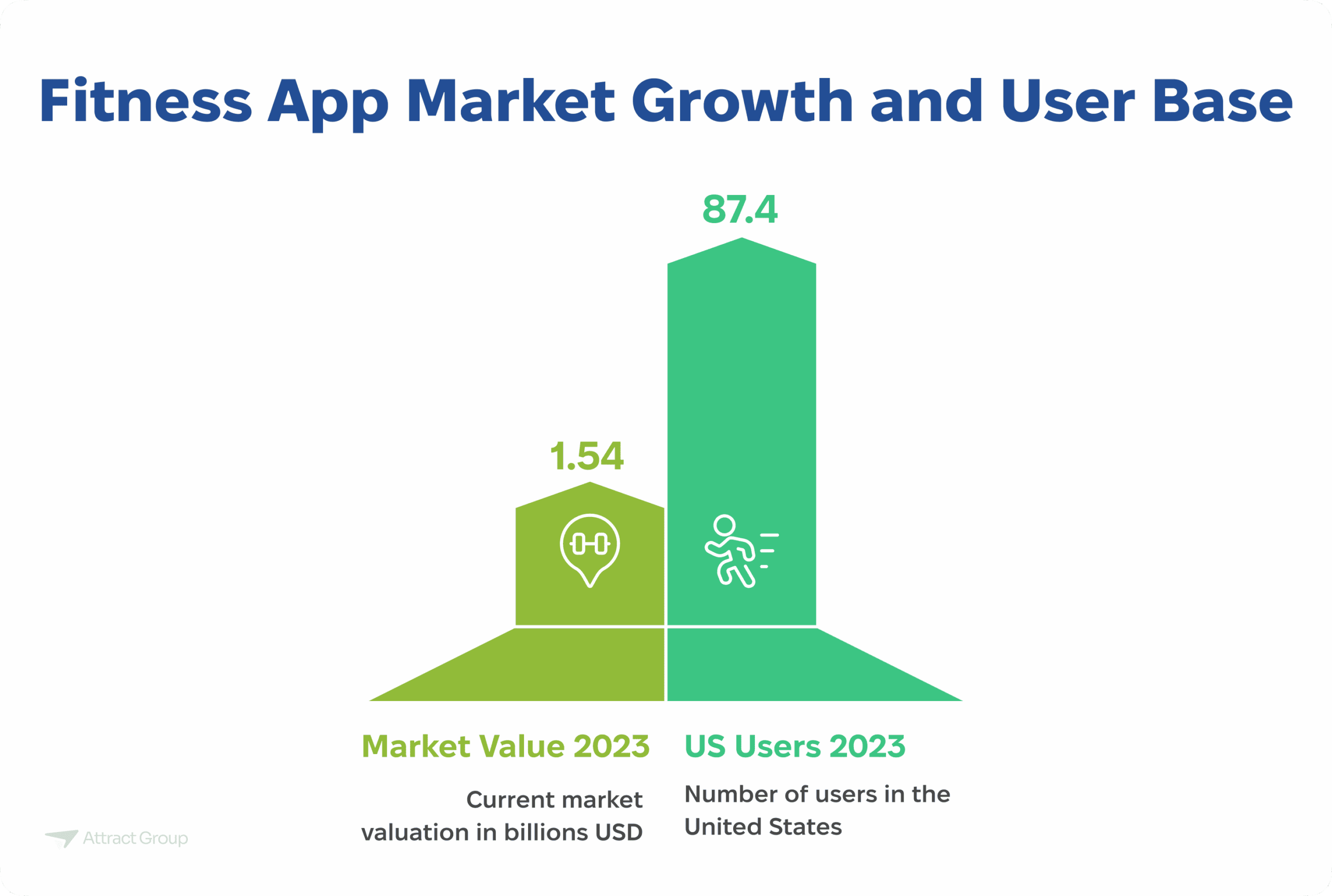
The key is to prioritize features that track various fitness activities, maintain engagement, and provide comprehensive health monitoring. By focusing on personalization and user experience, developers can create an app that not only helps users track their progress but also motivates them to stick to their fitness regimens long-term. This approach ensures the app stands out in this rapidly evolving and competitive market.
Key Takeaways and Next Steps
Working with experts in fitness app development can turn an idea into a big success. Adding real-time tracking, custom workouts, and diet tips is key. Using AI, VR, and wearables can also make a big difference. There’s a growing demand for customized fitness options. Apps that adapt to each user see a 27% jump in user loyalty. So, making your app fit each user’s needs is essential for keeping them happy.
Encouragement to Start Building Your Fitness App Today
Now’s the time for creators and developers to enter the fitness app scene. Smartphone use is up, with 3.5 billion users worldwide in 2021. Matching your app to what users want can grab you a big market share. Adding game-like elements could boost user activity by 40%. And social features could help build a community that 70% of users look for. If you’re ready to create a unique and engaging fitness app, go for it. The time is now for digital fitness innovation.
FAQs
What are the essential features to include in fitness app development?
A fitness app must have features like tracking workouts and nutrition. It should also offer personalized plans and social ways to connect. Features like health metrics, competitions, and coaching are important too. And don’t forget about accessibility and integration with wearable devices.
How can real-time workout tracking benefit users in a fitness app?
Real-time tracking gives instant data on workouts. This allows for control, tailored advice, and motivation from seeing progress.
Why should a fitness app offer personalized workout plans?
Personalized plans boost user engagement by meeting their unique fitness goals. This directed approach helps in achieving results, keeping users active on the app.
How does integrating nutrition tracking in a fitness app improve user experience?
Nutrition tracking alongside workouts offers a full health approach. It leads to wiser food choices and helps in tracking calories for fitness success.
What role do social integration features play in fitness apps?
Social features help users connect and share wins. They encourage community challenges and help the app’s growth by engaging users outside the app.
How can real-time progress monitoring motivate app users?
Seeing progress in real-time motivates users. It provides clear goals and rewards like badges, which boost app usage.
Why is it important to track health and fitness metrics in an app?
Tracking health metrics informs user decisions and goal setting. It shows improvement and aids in a more effective fitness routine.
How do community challenges and competitions engage users?
Community contests bring a fun, competitive side to fitness. They encourage motivation with leaderboards and rewards.
What is the significance of virtual coaching in fitness apps?
Virtual coaching offers personalized guidance anywhere. It uses AI for a tailored training similar to a live session.
How do accessibility features in fitness apps ensure usability for a wider audience?
Accessibility makes fitness apps usable for everyone. This inclusivity allows all to enjoy fitness and wellness activities.
Why is integration with wearable devices important in fitness apps?
Wearable integration enhances app functions for workout and health tracking. It offers convenience and improved accuracy, making fitness efforts more effective.
How do innovative features like AI and VR enhance fitness apps?
AI and VR offer unique, engaging exercise experiences. They provide motivation and personalized ways to meet fitness goals.
What steps should be taken to develop a fitness app that stands out in the fitness industry?
Developers should understand user needs and mix essential with advanced features. Teaming up with experts will create a unique app that effectively meets fitness goals.










